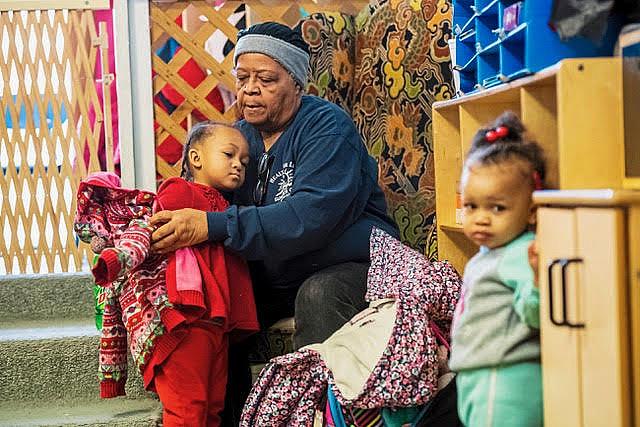A fragmented Pittsburgh makes it harder for kids to climb out of crushing poverty

Evelyn West, great grandmother of Kee'Mayah West, 2nd grader, of North Braddock, Pa., dresses children at Great Start Day Care in North Braddock in February, 2019.
Some life journeys start at a good day care center and end at the heights of academia. Some journalistic journeys go the other way.
In late 2017, we reached out to University of Pittsburgh demographer Chris Briem with this question: How should we go about identifying the communities most in need of our reporting?
His answer: Look at child poverty. It’s a metric that gets at community distress, and one that relatively few readers will dismiss out of hand. After all, while some blame adults for their economic circumstances, few would blame children for being born in poverty.
Roughly 18 months later, we're preparing to host a second-grade girl, her family and her day care provider in our newsroom, and then to deputize her as a special correspondent from the impoverished community of North Braddock.
Here's how we got from the stats to the streets.
Our demographer friend helped us with our initial review of American Community Survey data on the 500-plus municipalities in southwestern Pennsylvania, from which we identified a dozen communities in which half or more of youths lived in poverty. A mix of mill towns and coal patches, they were, by and large, communities of modest size and even more modest resources, a function of the governmental fragmentation of the Pittsburgh region.
Fragmentation is a perennial issue in southwestern Pennsylvania. Among regions of more than 1 million people, ours has the most governments per capita. Rarely, though, has the effect of fragmentation on quality of life been brought into sharp journalistic focus.
Our hypothesis emerged: If governmental fragmentation doesn't necessarily cause concentrated poverty, it certainly makes it harder to combat economic deprivation and deal with its effects. Those small governments have tiny budgets to deal with public safety, infrastructure and economic development. Those born within their boundaries start at a disadvantage, face a host of adversities, and end with dramatically shorter life expectancies.
Prior to our USC Annenberg Center for Health Journalism 2018 Data Fellowship, we began analyzing much more data, largely from Allegheny County, which alone has 130 municipalities. We got data on tax bases, crime and health — from maternal smoking to age-adjusted death rates.
Using tools honed at the fellowship, including pivot tables, vlookups and scatterplots, we found correlations between child poverty rates and low educational attainment, transience, demand for public services and mental health help, child welfare cases and removals of kids from parental care. We found wild disparities in resources, with one municipality boasting a per capita property tax base of $340,000, and another just above $10,000. A decades-old revenue sharing plan wasn't coming close to evening the playing field. Fellowship mentor Paul Overberg helped us to tease meaning from the data, and urged us to avoid asking it to do too much. He also assisted us in identifying our “counterfactual” city — Louisville, Kentucky, where consolidated government has been accompanied by meaningful reductions in child poverty.
Our team of an editor, four reporters, two photographers and an illustrator fanned out to the communities high in child poverty. We kicked off our coverage with the former factory town of Rankin, and followed up with the rural landscape of Saltlick.
Along the way, we started hanging out at the Braddock Carnegie Library, where we held a community event. A library employee tipped us off to Great Start Day Care, in the center of North Braddock.
A borough of just under 5,000 people with a child poverty rate estimated at 62%, North Braddock is also one of the most violence-plagued communities in the region. Its budget allows only for an all-part-time police force and doesn't even allow the borough to dent the list of 400 abandoned homes. Great Start is located two doors down from a cell phone store that has been a hub of criminal activity.
While getting the Great Start story, we met Kee’Mayah West, then 7. She writes Great Start's daily affirmations, posted in its front window, as well as short stories with illustrations. Photographer Michael Santiago and I quickly pegged her as a potential partner in chronicling childhood in North Braddock.
In coming days, we'll introduce Kee’Mayah to our world, bringing her to the newsroom and to our printing plant. Then we'll reenter her world, for a weeklong immersion into North Braddock. The results should emerge in July.
Our journey suggests a few lessons:
1) Don't be afraid to ask big, broad, potentially dumb questions of the most knowledgeable people in your community.
2) Let the data guide you, but not rule you.
3) Engage with the community, and when a library employee tells you to go somewhere, do it!
4) Don’t think of the people you meet as “subjects.” Allow them to become guides on your journey, and potentially participants, rather than just sources.
5) We often ask people to allow us into their worlds. Occasionally, it's appropriate to invite them into ours, too.

